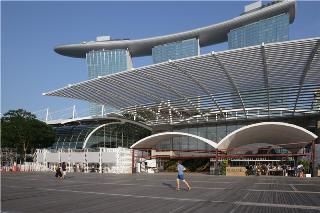Oct 13 2014
First-of-its-kind, light-as-cloud architectural technology boasts lower setup cost and time, and is set to revolutionise long-span architecture and construction.
 Cloud Arch on display at Marina Bay Sands (Photo credit: Fabian Ong)
Cloud Arch on display at Marina Bay Sands (Photo credit: Fabian Ong)
A research team from the National University of Singapore (NUS) has developed Cloud Arch™, an innovative, ultra-light architecture that will revolutionise the way large open public spaces, such as market, airport, stadium, concert hall, factory, are built.
This patent-pending technology is jointly developed by a research team led by Japanese architect Assistant Professor Shinya Okuda, who is from the NUS School of Design and Environment, and Professor Tan Kiang Hwee from the NUS Faculty of Engineering, in collaboration with structural engineering consultancy firm Web Structures.
Cloud Arch™ is a new generation of architectural technology that harnesses ultra-light materials to meet the construction needs of sustainable future. The first prototype debuted as one of the two winners of Archifest 2014 Pavilion Competition that was held in Singapore from May to June 2014. Cloud Arch™ was on display from 26 September to 11 October 2014.
Assistant Professor Shinya Okuda, who is from the NUS Department of Architecture, said, “Shed is one of the most primitive forms of architecture. We are interested in creating column-free space in a way that saves materials and time, by using ultra lightweight materials. We decided to use Expanded Polystyrene (EPS) foam, a widely used packaging material. More than 95% of this material is air, and its composite can be fire-resistant. After two years of prototyping and structural testing, we successfully developed a technique to control the composite material and applied it for the construction of long-span structures. This novel technology has been granted a provisional US patent.”
"We have also developed several prototypes - starting from a mere 4-metre span, to the current design comprising two sets of 14-metre span in the form of the Pavilion. As the design looks like a floating cloud, we called it Cloud Arch™," added Asst Prof Okuda.
Cloud Arch™: Lightweight, scalable, reduces costs and setup time
Elaborating on the merits of Cloud Arch™, Asst Prof Okuda said, "Structurally optimised forms are often doubly curved. By applying digital fabrication technology on the EPS foam, we could shape complex forms in a fast and cost-efficient manner. As the material is extremely lightweight, we could achieve significant savings in terms transportation cost as well as the time taken to set up and dismantle the structures. With Cloud Arch™, we hope to reduce the construction cost by one-third and construction time by half, compared to conventional construction materials, such as concrete.”
Professor Tan Kiang Hwee, who is from the NUS Department of Civil and Environmental Engineering, added, "EPS foam has almost similar compression strength to weight ratio as concrete and is currently used as landfill for landscape works. We are also testing its composite properties when reinforced with bonded fabric as a possible material for permanent construction."
Dr. Hossein Rezai, Director of Web Structures, which has been conducting structural simulations of the Cloud Arch commented, "A very encouraging fact is that, we have barely needed to increase the EPS composite thickness for the longer spans, but only to reinforce its composite strength. This implies that Cloud Arch's advantageous ultra-lightweight, will be further realised when the target spans get longer."
The research team’s next step will be to develop a 24-metre span factory roofing prototype. This project is supported by the NUS-JTC Industrial Infrastructure Innovation (I3) Centre, which was set up jointly by NUS and JTC Corporation in 2011 to promote the development of innovative and sustainable industrial infrastructure solutions in Singapore. Other possible applications of the technology include developing longer spans for airplane hangars.
Mr David Tan, Assistant CEO of JTC Corporation’s Development Group, said, “JTC is glad to support the project through the NUS-JTC I3 Centre. We hope that the Centre will continue to push the boundaries of innovation and explore new possibilities in sustainable industrial infrastructure solutions, land intensification, planning and design, and systems integration and optimisation, to support the transformation and growth of Singapore’s industrial landscape.”
Mr Theodore Chan, 54th President of Singapore Institute of Architect and Chairman of the Jury Panel for the Archifest 2014 Pavilion competition noted in the competition’s announcement letter dated 4 July 2014, "A breakthrough in technology, the patent-filed structural-foam of Cloud Arch™ intrinsically lends itself to a statement of true architectural form. The innovative use of fire-resistant structural foam coupled with technological research and rigorous testing, is a commendable effort on the part of the architect-designers behind Cloud Arch™. The efficiently spanned arched roof immediately achieves a 'wow' factor together with relative ease and speed of construction. In today's context of the industry's drive towards enhanced productivity and buildability, Cloud Arch™ represents great promise in material technology advancement."
On his vision for future applications of Cloud Arch™, Asst Prof Okuda said, "20th century visionary R. Buckminster Fuller once envisioned his invention Geodesic dome to cover 3km radius over the Manhattan in the 1960's for the energy efficient built environment. We hope that the Cloud Arch™ could make such a great impact on the sustainable built environment in the 21st Century.”